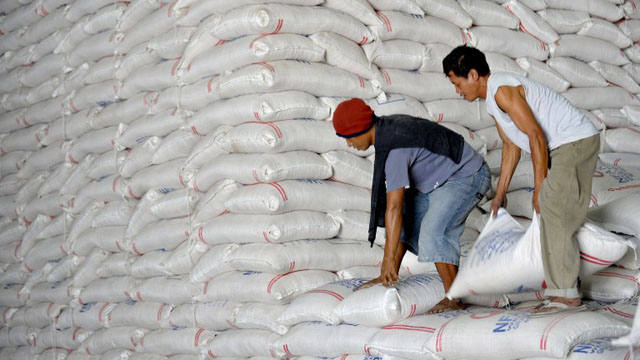SUMMARY
This is AI generated summarization, which may have errors. For context, always refer to the full article.

Rice stocks in the Philippines, one of the world’s key importers of the grain, fell to their lowest level in 6 months, with government and commercial warehouses holding barely a month’s supply to feed the country’s nearly 100 million people.
The Agriculture Department said rice inventories as of March 1, 2013 stood at 1.94 million metric tons, the lowest since Sept. 1, 2012. Since inventories reached 2.78 million tons on November 1, the level of rice stocks has fallen over 30%, government statistics showed.
The fall puts in perspective the decision by the National Food Authority (NFA), the government body which makes sure rice supplies are stable, to import 163,000 metric tons of rice.
While Manila has said the purchases are part of obligations under the World Trade Organization to import a total of 183,000 tons of rice in 2013, the shrinking stock level may have also spurred on the decision to bring the rice in at this time.
That leads to the next question: Will the imports be enough, or will more be needed?
Given the strength of rice demand and the need to boost stocks when the typhoon season hits, the wise money should be on more imports, not less.
The Philippines is one of the world’s top consumers of rice as the government of President Benigno Aquino said it is aiming to make the country self-sufficient in the grain this year.
A recent report by the US agriculture attaché in Manila said self-sufficiency in rice by the Philippines will likely remain out of reach. The report is compiled by US agriculture experts at its embassy in Manila and while it is not official US government data, it is considered authoritative by the commodity trading community.
“While the (government) has successfully increased rice production and reduced imports in its drive toward self-sufficiency, the country remains a major importer,” the report prepared by Perfecto Corpuz and William Verzani said.
They said marketing year (August/July) 2012/13 rice imports “are expected to remain at 1.5 million tons, inclusive of unregistered imports, and are forecast to decline to 1.2 million tons in MY 2013/14 due to improved production and the (government’s) import cap.”
“Most experts agree that a low milling rate, high tariffs (35-40 percent) and a thriving economy will keep the Philippines a significant rice importer for the foreseeable future,” the report concluded.
As far as inventories go at this time, rice stocks in government warehouses are good for 17 days of daily consumption while those in commercial warehouses are enough for 15 days.
The Philippines consumes about 35,000 to 36,000 tons of rice per day. Normally, the government should have about two to three months’ worth of stocks on hand.
Of the planned rice imports by the Philippines, some 98,000 tons will come from Thailand, one of the world’s top rice exporters, with 25,000 tons each coming from China and India, and the remaining 15,000 tons from Australia, the government had announced last week.
The imports are also being done ahead of the third quarter of 2013, when rice inventories in the Philippines seasonally drop to their lowest level for the year. Traders believe the imported rice will likely arrive in mid-May or later.
The Philippine Commodities Digest believes Manila’s total rice imports in 2013 will eventually reach at least 850,000 tons. U.S. agricultural experts from the USDA feel the imports would hit 1.5 million tons of rice. The experts’ forecast is not official USDA data.
The Philippine government is pinning its hopes on high-yielding seeds and improvements in infrastructure facilities such as irrigation to boost rice output in the country. But limits in the acreage planted to rice, historically low yields, and a surge in rice demand brought on by an increasing population may well blunt the government drive for self-sufficiency in rice. – Rappler.com
Note: The author is with Philippine Commodities Digest, a weekly publication of New Jersey-based A & V Media that provides a comprehensive roundup of developments and trends in the country’s farming sector.
Add a comment
How does this make you feel?
There are no comments yet. Add your comment to start the conversation.